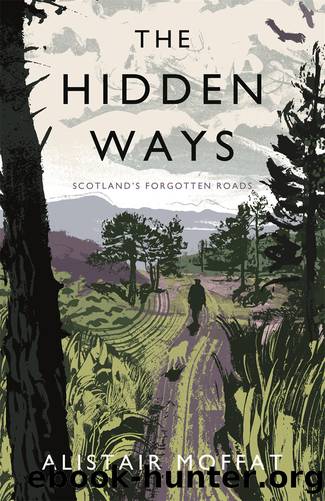The Hidden Ways by Alistair Moffat

Author:Alistair Moffat
Language: eng
Format: epub
Publisher: Canongate Books
5
The Road to Ruin
The Old Town, Edinburgh
Almost all of the hidden ways run through countryside, and when they approach cities or large towns their traces have often been obliterated. After Dere Street reaches the southern suburbs of Edinburgh, it disappears. But it seemed perverse to ignore the cities entirely, so I decided to include one urban route that has altered little since it was laid out in the Middle Ages.
In the later eighteenth century, when the Georgian New Town was built, Edinburghâs High Street was largely abandoned by those who might be seen as the Scottish establishment: lawyers, politicians, intellectuals. They wanted âhouses by themselvesâ across the drained Nor Loch. Throughout the nineteenth century, the High Streetâs tenements were conserved almost by default, lasting long enough into the twentieth century to be saved by pressure groups.
The High Street is not long, but it is very detailed, much more than two parallel lines of tall buildings. Most of all, it was a theatre, a public space where some of Scotlandâs history was played out. And behind the colourful clutter of tourism, it has recently re-acquired great status, as the Scottish Parliament was reconvened there in 1999.
I love the High Street. I have a very personal connection with its cobbles, closes and vertiginous tenements because I used to work there. And although its line is in no sense hidden, its heart, soul and history can sometimes be obscure. I hope that what follows casts it in a new light.
After a dazzling series of victories in the Highland winter, James Graham, the Marquis of Montrose, found himself trapped. His royalist army was in the Great Glen on 8 January 1645 when the general met Iain Lom, the MacDonald bard. He brought bad news. Two Covenanter armies, fighting on the side of the Parliamentarians in the English Civil War, had been deployed against him, one at each end of the Great Glen, blocking any advance or retreat. At Inverness the Earl of Seaforth, Chief of Clan Mackenzie, was encamped with 2,000 troops, while at Inverlochy Castle, near Fort William, 3,000 men were under the command of Sir Duncan Campbell, a battle-hardened soldier. Although Seaforthâs was the smaller force, Montrose decided to march south to meet the Campbells. With a force of MacDonalds, Stewarts and MacDonnells, there was no need to incite them to fight. Their hated blood enemies were at Inverlochy.
With superior numbers, Sir Duncan Campbell wanted to fight on open ground where his strength would tell, and he sent scouts to watch the road by Loch Lochy. Montrose and his men had to come that way, there was no other choice. And he would attack on open field, ground of his choosing. Intelligence told Campbell that he would face only about 1,500 royalists and his force ought to be able quickly to outflank Montrose, roll up his smaller army and fatally encircle them. Then the killing would begin.
Meanwhile Montrose and his great ally, Alasdair MacColla, were talking to the Camerons. This was their country and they knew of a high pass to the south-east of the Great Glen.
Download
This site does not store any files on its server. We only index and link to content provided by other sites. Please contact the content providers to delete copyright contents if any and email us, we'll remove relevant links or contents immediately.
| Africa | Americas |
| Arctic & Antarctica | Asia |
| Australia & Oceania | Europe |
| Middle East | Russia |
| United States | World |
| Ancient Civilizations | Military |
| Historical Study & Educational Resources |
Magic and Divination in Early Islam by Emilie Savage-Smith;(1498)
Ambition and Desire: The Dangerous Life of Josephine Bonaparte by Kate Williams(1342)
Bohemians, Bootleggers, Flappers, and Swells: The Best of Early Vanity Fair by Bohemians Bootleggers Flappers & Swells- The Best of Early Vanity Fair (epub)(1341)
Papillon by Henry Charrière(1305)
Twelve Caesars by Mary Beard(1253)
Operation Vengeance: The Astonishing Aerial Ambush That Changed World War II by Dan Hampton(1134)
What Really Happened: The Death of Hitler by Robert J. Hutchinson(1126)
London in the Twentieth Century by Jerry White(1110)
Time of the Magicians by Wolfram Eilenberger(1084)
Twilight of the Gods by Ian W. Toll(1083)
The Japanese by Christopher Harding(1081)
Lenin: A Biography by Robert Service(1041)
The Devil You Know by Charles M. Blow(983)
A Social History of the Media by Peter Burke & Peter Burke(936)
Freemasons for Dummies by Hodapp Christopher;(921)
Napolean Hill Collection by Napoleon Hill(899)
Henry III by David Carpenter;(890)
The Churchill Complex by Ian Buruma(879)
The Rise and Triumph of the Modern Self by Unknown(877)
